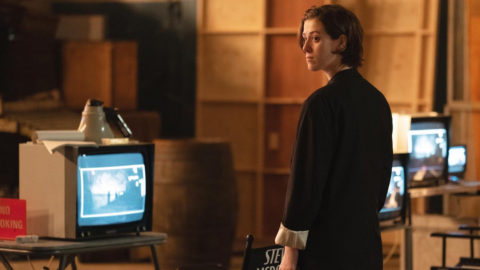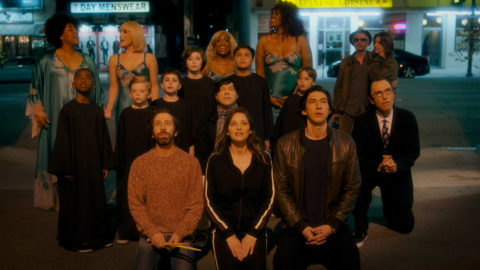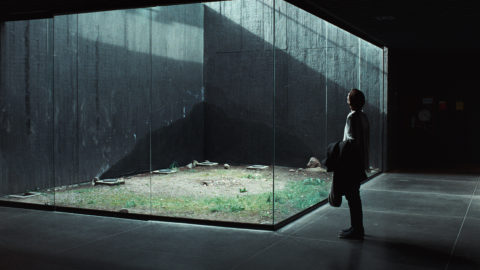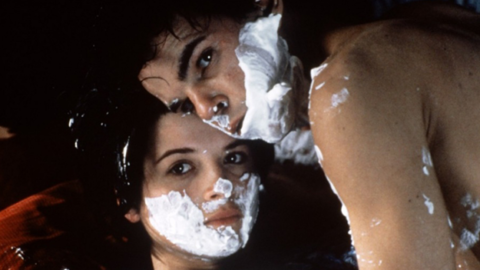Mind Games
This article appeared in the August 5 edition of The Film Comment Letter, our free weekly newsletter featuring original film criticism and writing. Sign up for the Letter here.
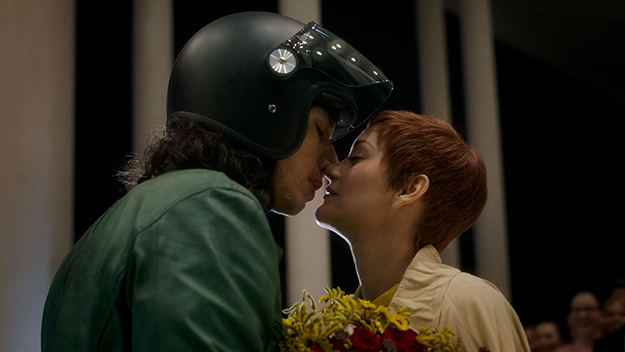
You can’t say you weren’t warned. A flamboyantly eccentric musical that both fulfils and obliterates the brief of its genre, Annette opens with a pre-show announcement admonishing the audience to silence themselves: “We now ask for your complete attention. If you want to sing, laugh, clap, cry, yawn, boo, or fart, please do it in your head, only in your head. You are now kindly requested to keep silent and to hold your breath until the very end of the show. Breathing will not be tolerated. So please take a deep, last breath right now.” This is an impish note on which to open a musical that exerts considerable lung power and intense physicality across its 140-minute runtime, but Annette quickly makes good on its suggestion that we are being invited to a performance altogether more cerebral than corporeal, a melodrama for the mind.
Directed by Leos Carax from a story hatched by Ron and Russell Mael of the band Sparks, who also provide the wall-to-wall soundscape, Annette kicks off with a number called “So May We Start,” a big ole welcome-to-the-show! extravaganza that parts a curtain on the band as they rev up the tune and, accompanied by the film’s cast and an elaborate tracking shot, spill onto the streets of Los Angeles. The song’s infectious refrain (“May we start? May we start? May we start! May we start!!”) might tempt you to defy the orders we’ve just been given; if there is ever a moment in Annette that could get your toes tapping, this is it. In retrospect, this rousing ditty may be the most perverse note struck in a movie dedicated, above all else, to barnstorming the viewer with formal idiosyncrasies. It is the first and last time the movie is unambiguously solicitous of its audience, looking us square in the eye and opening its arms to the conventional pleasures of a musical. Sparks, of course, are not Sondheim, and one does not head into a Carax film expecting tidy genre satisfactions. “So May We Start” is not a request but a provocation. Carax & co. are not asking for our blessing so much as announcing the advent of a musical contraption whose mode of address is more devoted to estrangement than entertainment. We have indeed started and it’s about to get weird.
Adam Driver is Henry McHenry, a bad-boy comedian on a downward spiral whose redundant moniker anticipates the dwindling novelty of his act. Flailing about the stage in a ratty bathrobe, black boxer shorts, and sockless loafers, Henry’s act, entitled “The Ape of God,” is a peculiar assemblage of self-loathing, half-articulate meta-confessions, audience baiting, inscrutable performance-art gesticulation, random non-sequiturs, and intermittent anti-zingers: “trying to be funny here is like trying to enjoy a blowjob in a gas chamber.” The routine is incoherent but mesmerizing. A jumble of signifiers tumbling through the void, Henry’s show is emblematic of Annette’s insistent perversity and the first of many scenes that suggests Annette is what happens if you made a backstage musical about the personages inhabiting Mulholland Drive’s Club Silencio.
Meanwhile, Ann Defrasnoux (Marion Cotillard) occupies a more dignified, if no less phantasmic career dimension as a renowned opera singer; in one of the film’s more dizzying coups de théâtre, she wanders into a forest backdrop that, through the lifting of a curtain, becomes suddenly… literal. All the world’s a stage and anything can happen in Annette. Henry and Ann are lovers and conceive a child—or rather, give birth to a prop. Baby Annette takes form as an animatronic puppet, a creepy-cute Howdy Doody What The Fuck with visibly articulated limbs and unnervingly blank affect. The most surprising effect of her arrival is how natural—even inevitable—it plays. By the time Annette enters the scene, Annette has so comprehensively defamiliarized storytelling norms that we scarcely skip a beat.
Particularly in its first and strongest hour, Annette orchestrates a delirious cinematic flex. Carax’s montage is the true diva here: the film’s tumultuous, shot-by-shot unpredictability piles up extravagances of mise en scène into a headlong mise en abyme. For all the passion on display, the movie’s primary source of heat is an exuberant formalism. Reflexive flourishes, surrealist interludes, and blatant artifice erupt with abandon. Nearly every “emotion” or “plot development” feels bracketed by quotation marks, which are further commented on by additional framing devices—like tabloid TV segments that report on the celebrity couple’s tumultuous affair. At once fascinating and exhausting, Annette ceaselessly reflects on the nature of its own meta-commentary: a backstage musical about Club Silencio filtered through the rhetorical sensibility of Southland Tales.
I will admit to breaking protocol and audibly laughing—just once, dear reader—at the sheer wackadoodle audacity of it all. Much of the story is best withheld and most of it amounts, in the end, to not very much. Henry and Ann grow increasingly unhappy and a tragic turn of events puts the fate of Baby Annette at stake. For all its peculiarities, the narrative is ultimately quite conventional, a showbiz love story with a fairy-tale twist about a moody jerk, a woman wronged, and the child caught between them. There are, needless to say, considerable quirks to how this all unfolds, replete with storm-tossed yacht peril, courtroom drama, murderous subplots, paternity controversies, and the rise of Baby Annette as a star in her own right, enthralling audiences with her angelic voice while levitating atop humongous trapezoids borrowed from Kanye’s Yeezus tour.
The movie ends marvelously with a downbeat dénouement that recapitulates Annette’s themes of artifice and performance with an eruption of magic realism in reverse: a revenge of the real that cuts through the noise. If the movie is dominated, to diminishing returns, by the vicissitudes of Henry’s angst, it’s named after Annette for a reason. The final twist of this capricious saga is to give itself over to her hands, to cut the puppet strings and fill her lungs with a final, sweetly sung rebuke of the wreckage of her upbringing. So may we end? When the curtain falls on Annette, you’re unlikely to laugh or cry, though it’s impossible not to applaud the sheer chutzpah of it all.
Annette might be understood as neither a meta-musical nor an anti-musical but rather a deep dive into the irreducible strangeness of the musical form—of cinema tout court—that we accept through habit and convention. That was, after all, the lesson of Club Silencio: the very premise of sync sound operates at the edge of an enigmatic void. The pact we make with movies (may we begin?) is a contract whose terms are all up for negotiation. Carax drills into the anti-realist essence of the musical and extrapolates the latent imposture at its core. The movie is populated by more than one automaton. Cotillard and Driver throw themselves at the scenario with everything they’ve got, but their exertions feel oddly inert. At once idealized and underwritten, Ann is tossed overboard by a plot whose concerns lie elsewhere. The larger Henry looms, brooding his way through the machinations of the tale, the less interesting he becomes, just another damaged douchebag celebrity patriarch. The entire movie is a kind of uncanny puppet, jerked through its melodramatic paces and reflexive hijinks by the obscure dictates of its puppetmaster auteur. “The authors are here so let’s not show disdain,” runs a couplet from “So May We Start”; “the authors are here and they’re a little vain.”
Nathan Lee is a longtime contributor to Film Comment and teaches film and media studies at Emory University.



